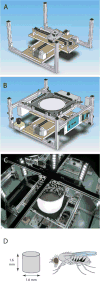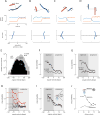A simple strategy for detecting moving objects during locomotion revealed by animal-robot interactions
- PMID: 22727703
- PMCID: PMC4638419
- DOI: 10.1016/j.cub.2012.05.024
A simple strategy for detecting moving objects during locomotion revealed by animal-robot interactions
Abstract
An important role of visual systems is to detect nearby predators, prey, and potential mates, which may be distinguished in part by their motion. When an animal is at rest, an object moving in any direction may easily be detected by motion-sensitive visual circuits. During locomotion, however, this strategy is compromised because the observer must detect a moving object within the pattern of optic flow created by its own motion through the stationary background. However, objects that move creating back-to-front (regressive) motion may be unambiguously distinguished from stationary objects because forward locomotion creates only front-to-back (progressive) optic flow. Thus, moving animals should exhibit an enhanced sensitivity to regressively moving objects. We explicitly tested this hypothesis by constructing a simple fly-sized robot that was programmed to interact with a real fly. Our measurements indicate that whereas walking female flies freeze in response to a regressively moving object, they ignore a progressively moving one. Regressive motion salience also explains observations of behaviors exhibited by pairs of walking flies. Because the assumptions underlying the regressive motion salience hypothesis are general, we suspect that the behavior we have observed in Drosophila may be widespread among eyed, motile organisms.
Copyright © 2012 Elsevier Ltd. All rights reserved.
Figures




Comment in
-
Visual neuroscience: how flies segregate moving objects from the optic flow field.Curr Biol. 2012 Jul 24;22(14):R565-7. doi: 10.1016/j.cub.2012.05.044. Curr Biol. 2012. PMID: 22835789
References
-
- Conway Morris S. The crucible of creation: The Burgess Shale and the rise of animals. Oxford: Oxford University Press; 1998.
-
- Hassenstein B, Reichardt WZ. Systemtheoretische Analyse der Zeit, Reihenfolgen, und Vorzeichenauswertung bei der Bewegungsperzeption des Russelkafers, Chlorophanus. Naturforsch. 1956;11b:513–524.
-
- Reichardt W, Poggio T. Figure-ground discrimination by relative movement in the visual-system of the fly. 1. Experimental results. Biol Cybern. 1979;35:81–100.
-
- Koenderink JJ. Optic Flow. Vision Res. 1986;26:161–179. - PubMed
-
- Lehrer M, Srinivasan M. Freely flying bees discriminate between stationary and moving objects: Performance and possible mechanisms. J Comp Physiol A. 1992;171:457–467.
Publication types
MeSH terms
Grants and funding
LinkOut - more resources
Full Text Sources
Molecular Biology Databases

